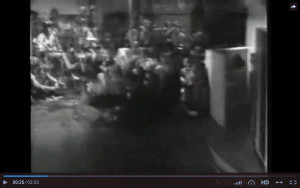“All You Need Is Love”, 1967. It’s still tricky to pin down exactly what was going on with the amps in the broadcast and recorded versions of ” ..this old Northern English folk song” (as Elvis Costello called it at Live Aid). People weren’t going out of their way to document and photograph amplifiers in the background, or precise elements of all the many mixes involved in editing the recording. Somewhere in the recorded “All You Need” mix there’s still perhaps an element of the very first recording sessions; these actually started at Olympic studios, on 14th of June. It seems Paul had used his double-bass, plucking / with a bow and striking the side for percussion, and George even experimented with a violin. It seems elements of that are heard here, mixed with added parts, in a backing reference tape/mix;
Opinions differ as to who did what and when – Geoff Emerick in his book recalled that Paul played the bass perfectly, though others argue Paul makes a mistake in the broadcast near the end and pauses…and people argue over how much was live and how much was on the pre-recorded track. The tape above and others often show pre-mixes had flubs and errors, that were buried in the mix, so it is hard to tell where to draw the line..and we should perhaps be wary of any supposed ‘definitive’ break-down.
Things are further complicated by the chaotic events leading up to the recording. We looked previously at photos of rehearsals/pre-recording; we were able to show that in the lead-up at least to the broadcast, the amp being used seemingly by Paul was the UL-430. These rehearsals/pre-recordings seem to have taken place the day before, and during the day of the actual broadcast. At some point, probably on the day of broadcast, Lennon shaves off his moustache; amps and pianos were then moved around the studio as it was dressed on the day, for some sort of presentation, and the broadcast itself. At one point, a blurred image of a Vox Conqueror on a wheeled cab is seen in the background.
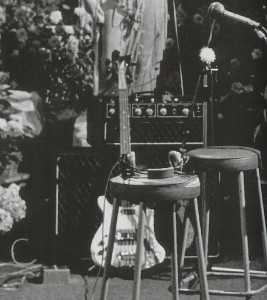 We know that for the final broadcast, the 430 head has been moved somewhere, and replaced with a Conqueror head; it looks like Paul was using the 430 (with the same microphone hanging in front for recording/monitoring) in the run-up, so people have argued over whether he was still using it, or if George was now using it for the broadcast…leaving Paul miming, or connected to a hidden amp/direct injection (intriguingly there’s a small metal box visible in front of the amp, d.i. ?).
We know that for the final broadcast, the 430 head has been moved somewhere, and replaced with a Conqueror head; it looks like Paul was using the 430 (with the same microphone hanging in front for recording/monitoring) in the run-up, so people have argued over whether he was still using it, or if George was now using it for the broadcast…leaving Paul miming, or connected to a hidden amp/direct injection (intriguingly there’s a small metal box visible in front of the amp, d.i. ?).
(A later pic of Paul/bass from about 68 also shows a similar small metal box, maybe on the way to an amp..)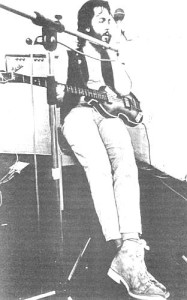
Trawling through other pictures from the day though, we were struck by one black and white photo with more of the scene to the right of George. This seems to be from the rehearsal/recordings, probably during the day itself; 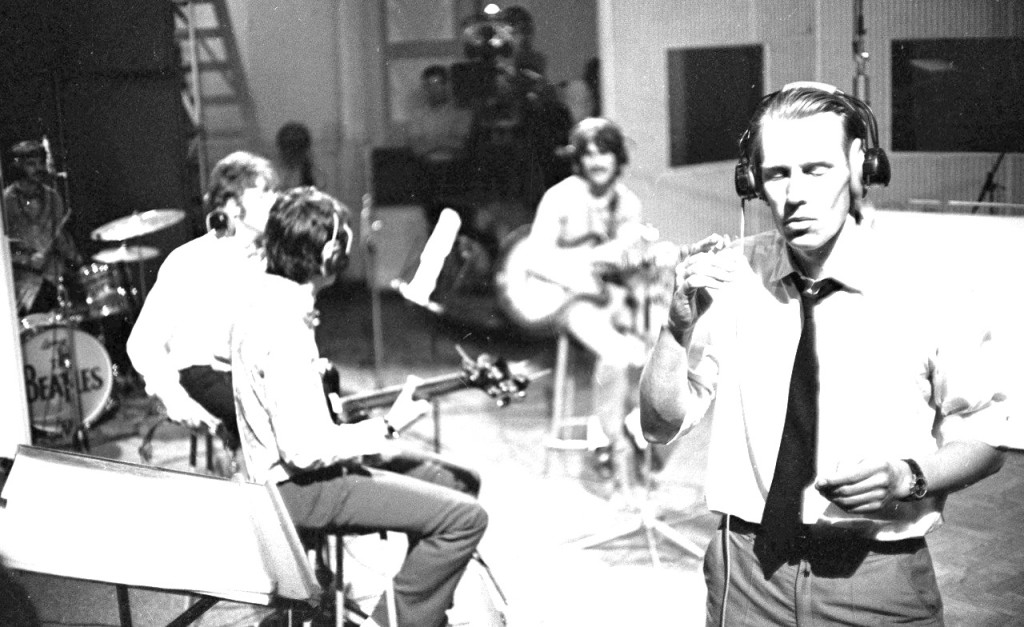
This got us wondering whether we might actually be looking at a screened amp/cab behind the baffle (behind George Martin on right), with a microphone stand pointing down in front of it? This might point to the ‘missing’ amp, maybe the Conqueror, at this point at least. (In the later Paul photo from ’68 above, there is a microphone stand with adjustment fixtures of the type that could give the sort of shape we see…or it might be something else entirely). While searching other photos though, we were struck by another photo of George, which doesn’t seem to have been assigned – it is usually described as being George during Pepper or Magical Mystery Tour era recording.
era recording.
The clothes he is wearing look to be the same as in some of these All-You-Need rehearsal/recording pics; shoes, shirt, something hanging round his neck (Lennon with no moustache, so probably the day itself, but not yet in full final outfits). 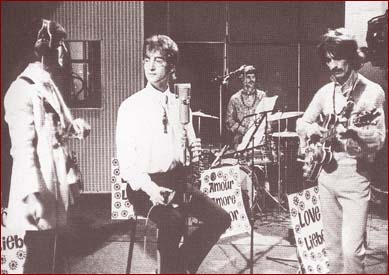 The situation too, that same part of the studio/ wall/divider area, that baffle…it seems reasonable to suggest (-someone probably has already?) that this is from the same time, and therefore shows the same amp that George was using. Probably the same Conqueror head too, that was plonked on top of the 430’s cab for the final broadcast? (It looks slightly askew, suggesting it wasn’t firmly secured to the cabinet). Another photo from that day showed a blurred amp/cab in the background behind Lennon, but while things were being moved around. Very suggestive, especially with the final use of a conqueror head. If this is the same amp, then it helps to give us an impression of an amp, cab and mike behind the baffle, and a better sense too of the equipment & arrangements in the lead-up to the broadcast. The Guitar/Bass Isolation Screens with the long chrome handles running along the top were introduced in late ’66; they had wooden frames, and fabric over an absorbent material filling (from Recording The Beatles).
The situation too, that same part of the studio/ wall/divider area, that baffle…it seems reasonable to suggest (-someone probably has already?) that this is from the same time, and therefore shows the same amp that George was using. Probably the same Conqueror head too, that was plonked on top of the 430’s cab for the final broadcast? (It looks slightly askew, suggesting it wasn’t firmly secured to the cabinet). Another photo from that day showed a blurred amp/cab in the background behind Lennon, but while things were being moved around. Very suggestive, especially with the final use of a conqueror head. If this is the same amp, then it helps to give us an impression of an amp, cab and mike behind the baffle, and a better sense too of the equipment & arrangements in the lead-up to the broadcast. The Guitar/Bass Isolation Screens with the long chrome handles running along the top were introduced in late ’66; they had wooden frames, and fabric over an absorbent material filling (from Recording The Beatles).
For the broadcast itself, that part of the studio was turned into a set, and many people were allowed in, some sitting on the floor in the area where the Conqueror & cabinet had been behind the baffle. Photos aren’t clear enough to say for sure who/what was where; we know a Conqueror head was moved over and put on top of the (430?) cab, which (we can now suggest a bit more firmly) Paul was using. One photo (below) seems to show the baffle, folded back. The style of the main cab’s logo shows it is probably one of the 4/7series cabinets, in the same place, without a trolley, and with the same mike/stand in front of it. The final broadcast ‘take’ was apparently take 58, which shows how much preparation had been needed to get to that stage. Photos of the Conqueror aren’t clear, but seem to show it only having one lead in; if George was now using the Conqueror (which we think was probably paired with the in-place 430/730 cabinet), then what amp if any was Paul using? It is possible the 430 was swapped over and put on top of the Conqueror cabinet, and then hidden somewhere in the space behind or tucked behind the foliage, or the signal split with the d.i….or perhaps d.i. out from the amp… or maybe just the pure d.i. signal was taken. Paul could also have mimed the bass; it would have been easy enough to have some/most of it incorporated in the previous recording of the backing track. Or maybe George used the d.i. …..but why move the Conqueror head? Vox asked Epstein maybe to use the new amp in shots? Why not just wheel the Conqueror with its cab on wheels over? And then we find another picture, with Paul standing near the same area, with the Conqueror in the background. 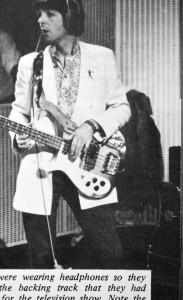 Paul seems to have had a long lead back to the 430 in the other pics, and we only have a limited view, but it does muddy the waters even more. Still so many questions… but even if we can’t see the complete picture, at least we can put a few pieces of the jigsaw in place.
Paul seems to have had a long lead back to the 430 in the other pics, and we only have a limited view, but it does muddy the waters even more. Still so many questions… but even if we can’t see the complete picture, at least we can put a few pieces of the jigsaw in place.
On the “DIT” box, the superb Kehew/Ryan “Recording the Beatles”, describes it as the ‘Direct Injection Transformer”. It was dreamt up by the innovative Ken Townsend; the second later pic of Paul with the bass seems to show one in use, and it looks very like the box by the amp in the All You Need rehearsal/recordings. The book states, “..the musician plugged his guitar into the middle jack, The cable coming from the box was the output to the guitar amplifier; the Tuchel socket on the Right provided a direct balanced output which could be sent to the desk”. The box is a squared-metal box, the right-hand Tuchel socket is much larger. “One of the most difficult instruments to record was the bass guitar…no matter which type of high-quality microphone we placed in front of the bass speaker, it never sounded back in the control room as good as in the studio…”. ‘Revolution’ would later see the Beatles recording in the control room itself, using these boxes to input direct to the mixing desk, while Ringo recorded drums in the studio without any sound bleeding through from the guitars.
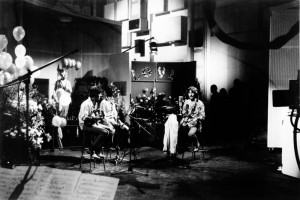
Costume change, Conqueror moved to main cab, but is that the baffle folded back on right, still with cab/mike there? 430 Head swapped over?
Some good info on “All You Need” sessions on web HERE
and this suggestion of final takes, 58 and the one before, from “Beatle Brunch” site HERE;
-
Live Take (57)
- 1. Bounce 2
- 2. Rickenbacker bass, lead Casino guitar solo, drums
- 3. lead vocal (Lennon), orchestra, chorus, tambourine
- 4. open
The final take, numbered 58, added Ringo’s snare drum roll and some additions to Lennon’s vocal part on Track 4.
-
Final Take (58)
- 1. Bounce 2
- 2. Rickenbacker bass, lead Casino guitar solo, drums
- 3. lead vocal (Lennon), orchestra, chorus, tambourine
- 4. Ringo’s roll in intro; Lennon vocal scatting at end

